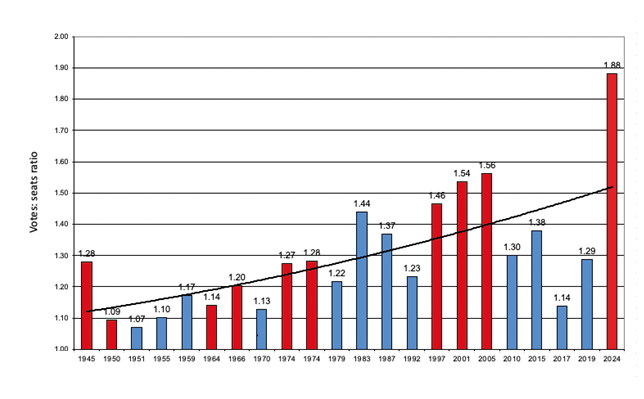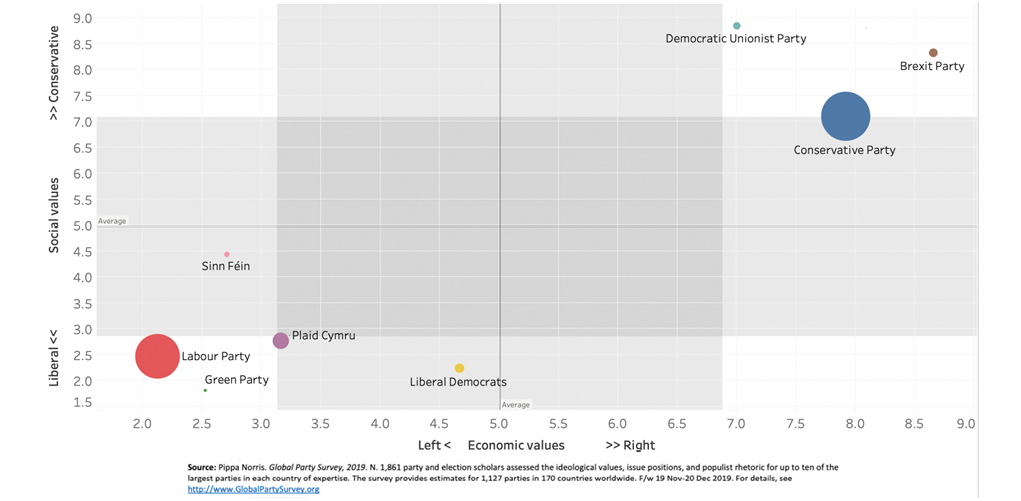
Prof Pippa Norris
McGuire Lecturer in Comparative Politics at Harvard University.
Email: Pippa_Norris@Harvard.edu

UK Election 2024
Section 1: Democracy and representation
1. Public anxiety and the electoral process (Prof Barry Richards)
2. How Nigel Farage opened the door to No. 10 for Keir Starmer (Prof Pippa Norris)
3. The performance of the electoral system (Prof Alan Renwick)
4. Tory downfall is democracy rectifying its mistakes (Prof Stephen Barber)
5. Votes at 16 and decent citizenship education could create a politically aware generation (Dr Ben Kisby, Dr Lee Jerome)
6. “An election about us but not for us”: the lack of communication for young people during GE2024 (Dr James Dennis)
7. Election timing: masterstroke or risky gamble? (Prof Sarah Birch)
8. The dog that didn’t bark? Electoral integrity and administration from voter ID to postal votes (Prof Alistair Clark)
9. A political gamble? How licit and illicit betting permeated the campaign (Dr Matthew Wall)
10. Ethnic diversity in politics is the new normal in Britain (Prof Maria Sobolewska)
11. Bullshit and Lies on the campaign trail: do party campaigns reflect the post-truth age? (Prof Darren Lilleker)
12. Stoking the culture wars: the risks of a more hostile form of polarised politics (Dr Jen Birks)
The 2024 UK General Election proved a watershed contest, with a stunning rejection of the Conservative government. The party’s share of the vote (24%) was its worst ever. In contrast the Labour Party made a historic leap, doubling the number of MPs (412) and winning almost two-thirds (64%) of all Westminster seats despite securing only one-third (34%) of the vote.
In the following days, heated post-mortems sparked a lively debate about the underlying reasons for this remarkable event. In particular, from a comparative perspective, why did the Labour Party achieve such a substantial victory, sweeping them back to power? This is all the more remarkable because it seems to buck the trend for the flagging electoral fortunes of centre-left social democratic parties, and the rise in popular support for authoritarian populists in parts of Europe as well as prospects for the reelection of Donald Trump in America.
Why did the Conservatives lose?
Many blamed the Conservative defeat on an anti-incumbency vibe and ‘time-for-a-change’. Fourteen years of Conservative rule saw multiple leadership contests, five prime ministers, sexual misconduct and corruption, and policy failures from the cost-of-living crisis to austerity cuts in public services. In particular, the public became widely disillusioned with Brexit when Boris Johnson’s sunny upland populist promises about the benefits of leaving the EU confronted the reality of falling living standards, growing inflation, and rising net migration. Under the Conservatives, Britain had sluggish productivity growth and high inequality.
Why did Labour win?
Therefore, the anti-incumbency mood helps to explain the historic loss of Conservative support. Why Labour won, however, needs to focus on the workings of the UK First Past the Post (FPTP) electoral system and patterns of multiparty competition.
As discussed elsewhere in this volume (Renwick), there are many ways to summarise the proportionality of any electoral system. The simplest is to divide the proportion of votes into seats. The plurality electoral system for Westminster resulted in a seats: votes ratio of 1.88 for Labour, the largest ‘winners’ bonus’ for any party in first place during the post-war era (see Figure 1). The overall share of the vote and its geographic concentration are essential for winning seats under this system. Minor parties and independent candidates can be elected if they campaign resources strategically in constituencies where their support is most concentrated, for example, in seats with high proportions of Muslim and young people for the five pro-Palestinian independent candidates returned to parliament. However, if minor parties like the Green and Reform parties try to campaign across the whole country, they may increase their overall share of the nationwide vote but still fail to win seats.

Note: The votes: seats ratio is produced by dividing the percentage of votes for the winning party into their percentage of seats. A ratio of 1.0 would be perfectly proportional. Source: House of Commons Library
Party competition is also critical. In Downsian models, in any contest parties seek to compete for the median voter in the centre of the political spectrum across the issue space. The December 2019 UK General Election model is illustrated in a two-dimensional issue space in Figure 2. The horizontal axis shows where experts located the UK parties on economic values, dividing those favouring state management versus free markets. The vertical axis shows where they placed the parties in their liberal or conservative social values, such as on minority rights and nationalism. Party competition in the liberal-left space, in the bottom left-hand quadrant, was a crowded field in 2019. Labour was flanked by the Greens, the nationalist parties, and, to a lesser extent, the Liberal Democrats. All these opposition parties divided the pool of British voters with liberal-left values. By contrast, the Conservative party enjoyed ‘clear blue waters’ in the top right-hand quadrant, with only the more extreme Brexit Party and the Democratic Unionists sharing this conservative-right space. In 2019, Nigel Farage announced that the Brexit Party would not contest Conservative seats. Instead, it would compete in opposition-held constituencies, where they failed to gain a single MP. This strategic decision allowed Boris Johnson to consolidate support among Leave voters, contributing towards his 80-seat majority.

Figure 2: Party competition in the 2019 UK General Election
By contrast, in the 2024 General Election, Nigel Farage decided to field 609 Reform candidates nationwide. The party won 14.3% of the vote share, or over four million votes, the third-highest popular vote of any party. For the first time, Nigel Farage was elected along with four other MPs, a critical breakthrough for the party, although the highly disproportional result is due to the FPTP system. By splitting the right-wing vote, however, the net effect of the Reform strategy was essentially to steal support from the Conservatives, to allow Labour and the Liberal Democrats to gain seats where they were in second place against the Conservatives, and thereby to throw open the door of No. 10 to Keir Starmer.
Therefore ‘throw-the rascals-out’ forces and negative partisanship make reelection challenging for all governing incumbents. Western governments face similar pressures from inflation, migration, cultural change, and international security, providing opportunities for minor parties to gain votes and seats. However, as argued elsewhere, the way that parties compete strategically within the rules of the electoral game is critical for understanding the outcome in each country, including the fortune of authoritarian populist parties.
